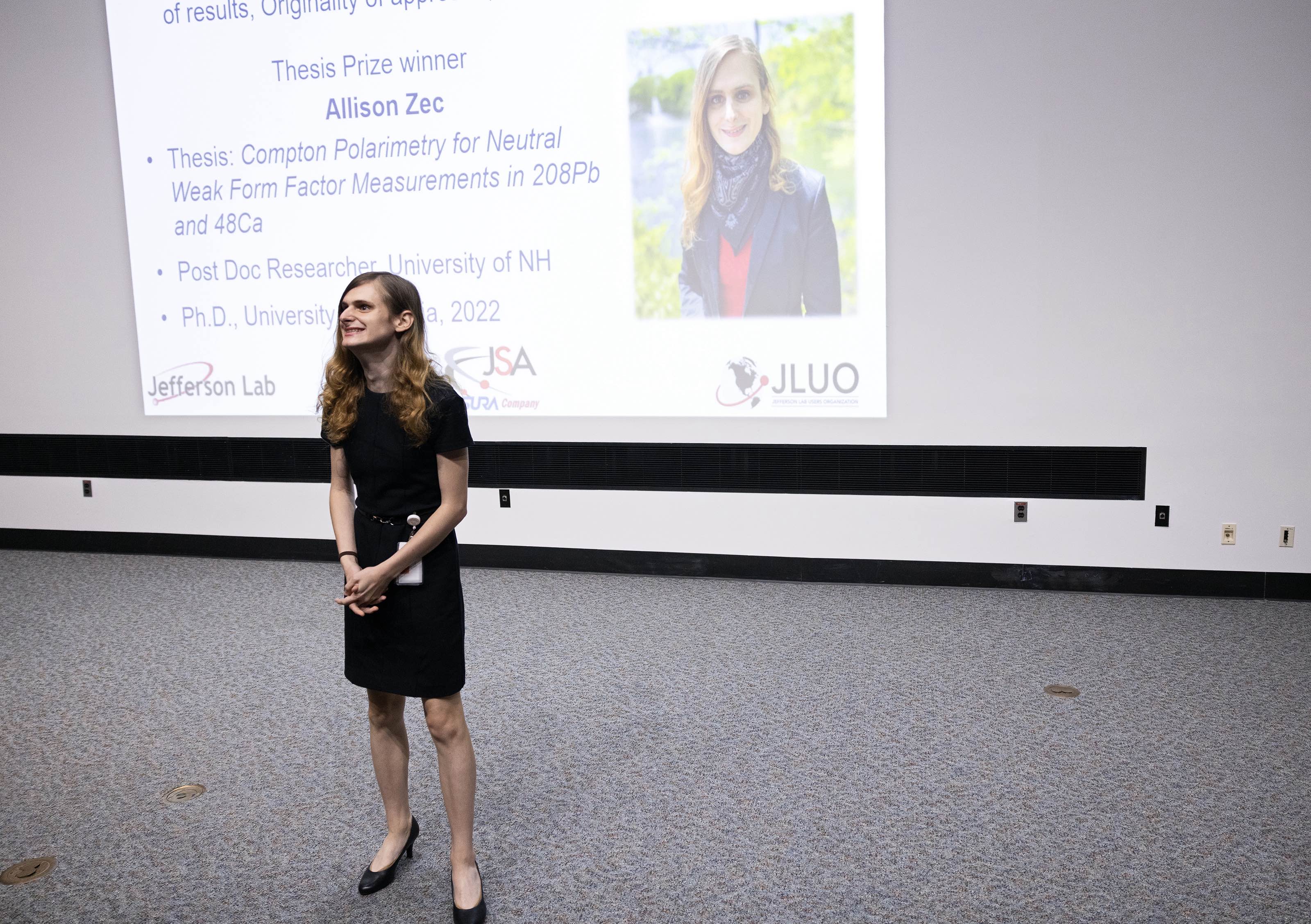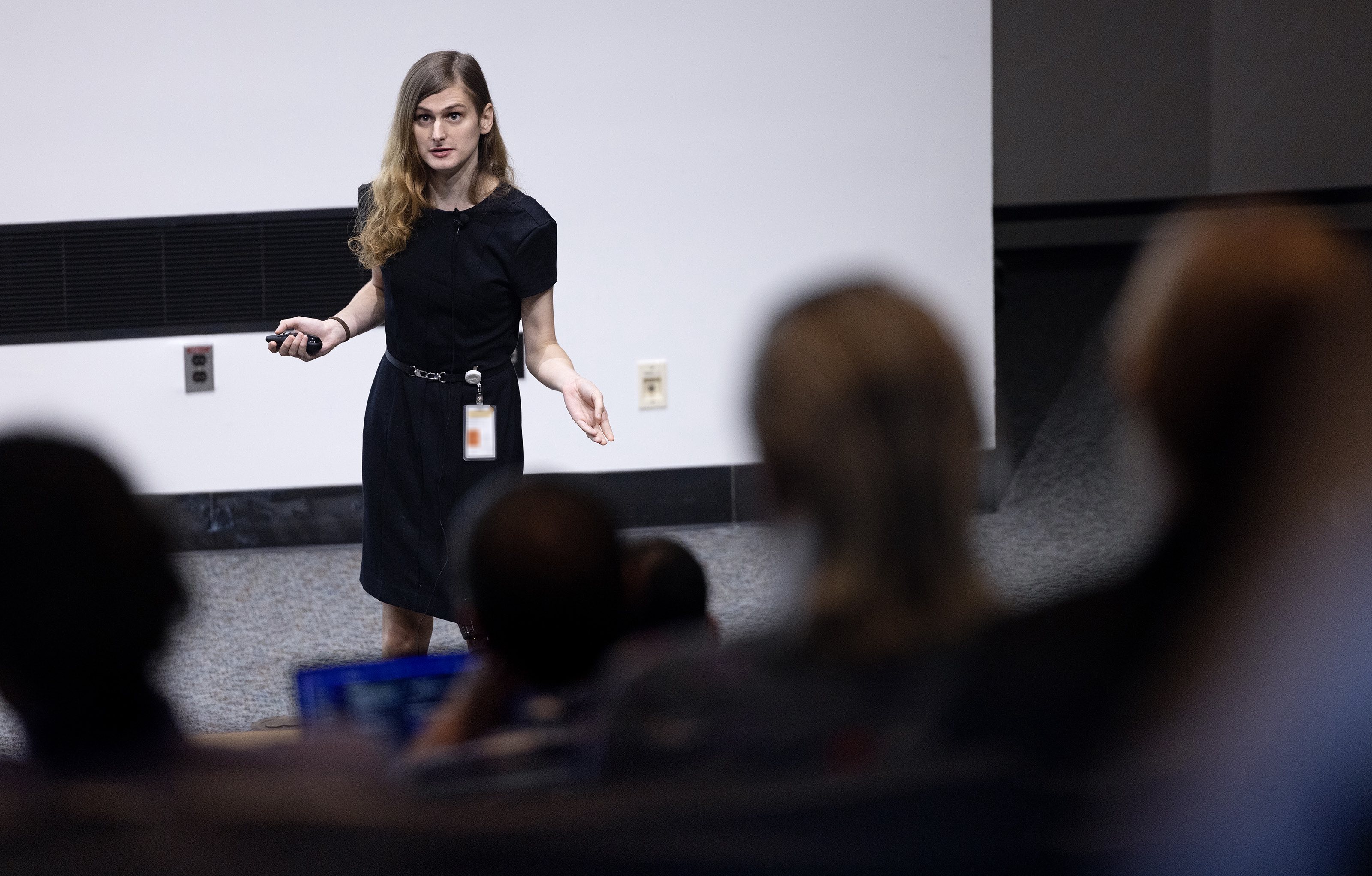Allison Zec, 2022 JSA Thesis Prize Award Winner, presents her work at the 2023 JLUO Annual Meeting. Jefferson Lab photos/Aileen Devlin
The 2022 JSA Thesis Prize goes to Allison Zec for recounting experiments that achieved the world record in the precise measurement of an electron beam’s polarization
NEWPORT NEWS, VA – A doctoral dissertation examining the most precise measurement of electron beam polarization ever made was just awarded the prestigious 2022 Jefferson Science Associates (JSA) Thesis Prize. Since 2017, award-winner Allison Zec has been part of a collaboration that ran experiments at the U.S. Department of Energy's Thomas Jefferson National Accelerator Facility.
The goal of both the CREX and PREX-II experiments was to run an experiment and its mirror opposite simultaneously to determine the structure of the nuclei of heavy atoms, such as calcium or lead. Both experiments were conducted in Experimental Hall A of Jefferson Lab’s powerful Continuous Electron Beam Accelerator Facility, or CEBAF. CEBAF is an Office of Science user facility that supports the research of more than 1,850 nuclear physicists worldwide.
Zec worked on Hall A’s CREX Compton polarimeter. This polarimeter is a device that uses Compton scattering, or the scattering of the electron beam with light, to measure the spin directions of electrons in CEBAF’s electron beam at any given time, yielding a quantity known as the electron beam polarization.
“The work that I presented in my thesis was that we had the most precise measurement of beam polarization ever undertaken, going all the way back to the record at DOE’s SLAC National Accelerator Laboratory in the 1990s,” Zec said. “We did this by looking at what could possibly throw off a result and a very thorough examination of any sources of uncertainty, and lo and behold we were able to measure the polarization to within half a percent, which is the record.
“I think that’s what made this dissertation work so interesting -- is that this record was set when I was in first grade, and we just blasted right through it.”
Not the why, but the what
Zec grew up in a Boston suburb in a family that valued learning and frequented the city’s Museum of Science. As a child, she wasn’t prone to ask her parents the “why” of the world, but rather, the “what.”
“I was fascinated by the idea that matter could keep having divisions further and further down,” Zec said. “I would ask my dad, What’s inside this carrot? And he’d say, ‘It’s water and some beta carotene.’ What’s inside beta carotene? ‘It’s molecules.’ What’s inside molecules? ‘Atoms.’ What’s inside atoms? ‘Protons, neutrons and electrons.’ What’s inside protons, neutrons and electrons? ‘Quarks.’ What’s inside quarks? ‘Well, we don’t know if there’s an inside to that.’”
An influential high school physics teacher set the hook by encouraging Zec to design an experiment using scintillator paddles left over from an experiment at DOE’s Fermi National Accelerator Laboratory outside Chicago. These paddle-shaped devices are used to detect charged particles as they pass through.
Zec set out to see if she could block the passage of muons, which are energized charged particles that pass through matter nearly unimpeded. It’s estimated that 10,000 muons pass through a human body every minute. Zec’s experiment attempted to block muons using materials from lead, to aluminum foil, to a bucket of water. It failed.
“That’s what really got me hooked — getting to use my creativity to come up with a test to have quantifiable results,” said Zec.
In 2015, she earned her bachelor’s degree from the University of Massachusetts, spending a summer at the Gran Sasso National Laboratory in Italy working on a dark matter detection collaboration. She started her doctorate at the University of Virginia in Charlottesville the same year.
At UVa, she joined experimental and nuclear physics professor Kent Paschke’s group, which was involved in the CREX and PREX-II experiments. It was then that she became the point person for the Compton polarimeter.
Her dissertation is called “Compton Polarimetry for Neutral Weak Form Factor Measurements in 208Pb and 48Ca.” She was informed that the JSA selection committee voted unanimously to award the composition its Thesis Prize for work completed in 2022.
“I see it as a huge honor,” Zec said. “It’s a good sign that they’re, like, we think your work is valuable and we’re willing to help you along the way.”
‘The spirit of discovery’
The Thesis Prize was established in 1999 to reward the top doctoral dissertation on research related to Jefferson Lab science. It’s funded by the JSA Initiatives Fund program, which supports programs, initiatives and activities that further the scientific outreach and promote the science, education and technology missions of Jefferson Lab, and which benefit the laboratory’s scientific user community.
A handful of women have earned the prize since its inception. Zec is proud to be the first open transgender person to do so.
She credits several mentors for her success, including Paschke at UVa and Dave Gaskell at Jefferson Lab, whom she considers a calm presence and “the ideal of what a physics mentor should be.”
Zec is now a postdoctoral researcher at the University of New Hampshire Polarized Target Group in Durham, New Hampshire, where she’s helping to design experiments using spin polarized targets in the ongoing effort to unlock the mysteries of matter. The group has a series of experiments already approved to run at Jefferson Lab in the next several years, as well as more proposals in the works.
“It’s about the spirit of discovery,” said Zec of fundamental physics. “We don’t have an instruction manual for the universe; that was never something that was handed down to us. We’re figuring this out collaboratively.
“I think what particle physics contributes to society is that it’s a microcosm for us figuring out how we’re going to work together to solve bigger problems, because the logistics of trying to figure out the exact spin structure of, let’s say deuterium, are the same as solving real societal issues.”
Further Reading
Scientists Measure Calcium’s Thin Skin
Physicists Net Neutron Star Gold from Measurement of Lead
Probing the Skin of a Lead Nucleus
It’s Elemental: The Periodic Table of Elements
By Tamara Dietrich
Contact: Kandice Carter, Jefferson Lab Communications Office, 757-269-7263, kcarter@jlab.org



